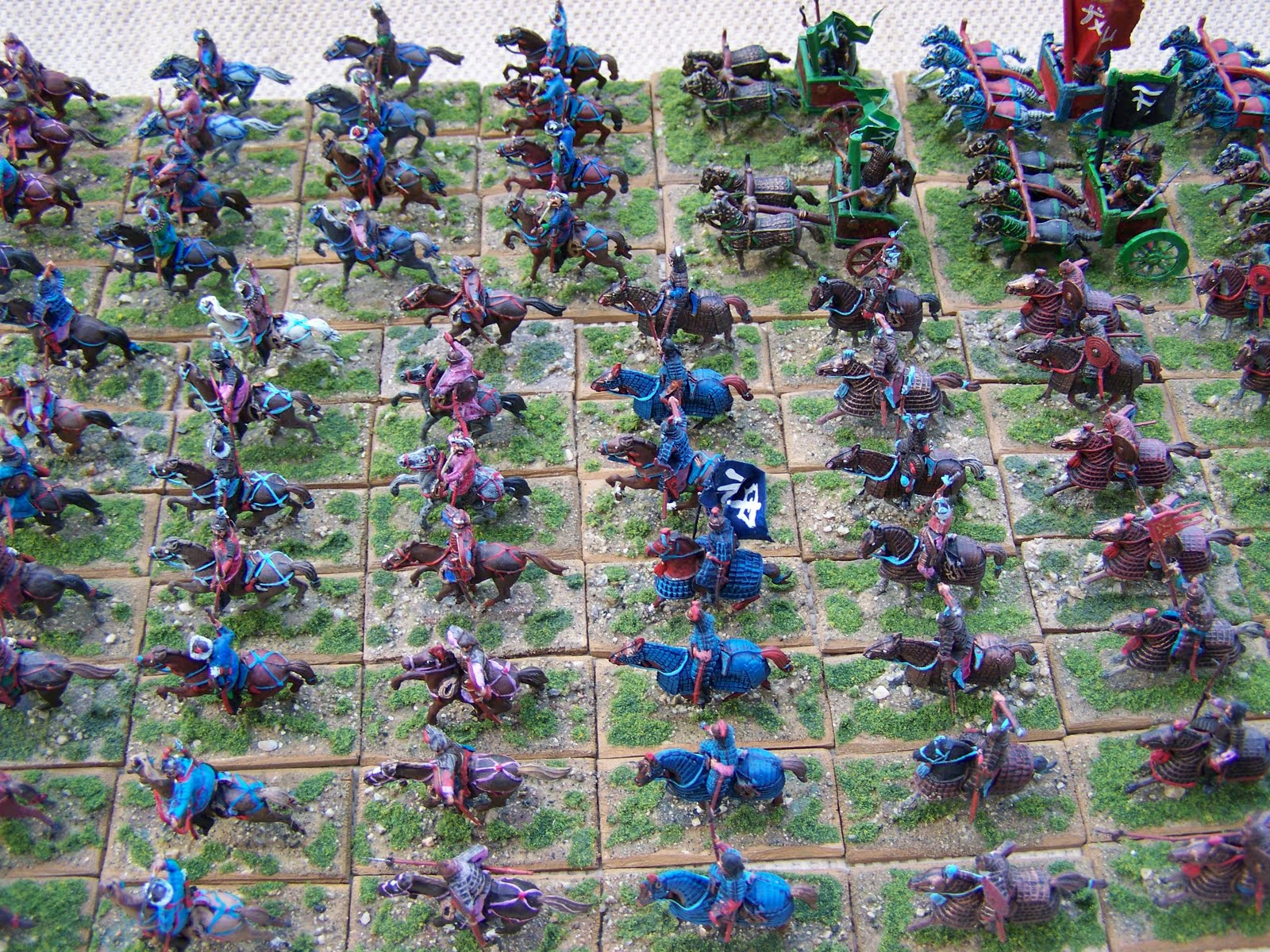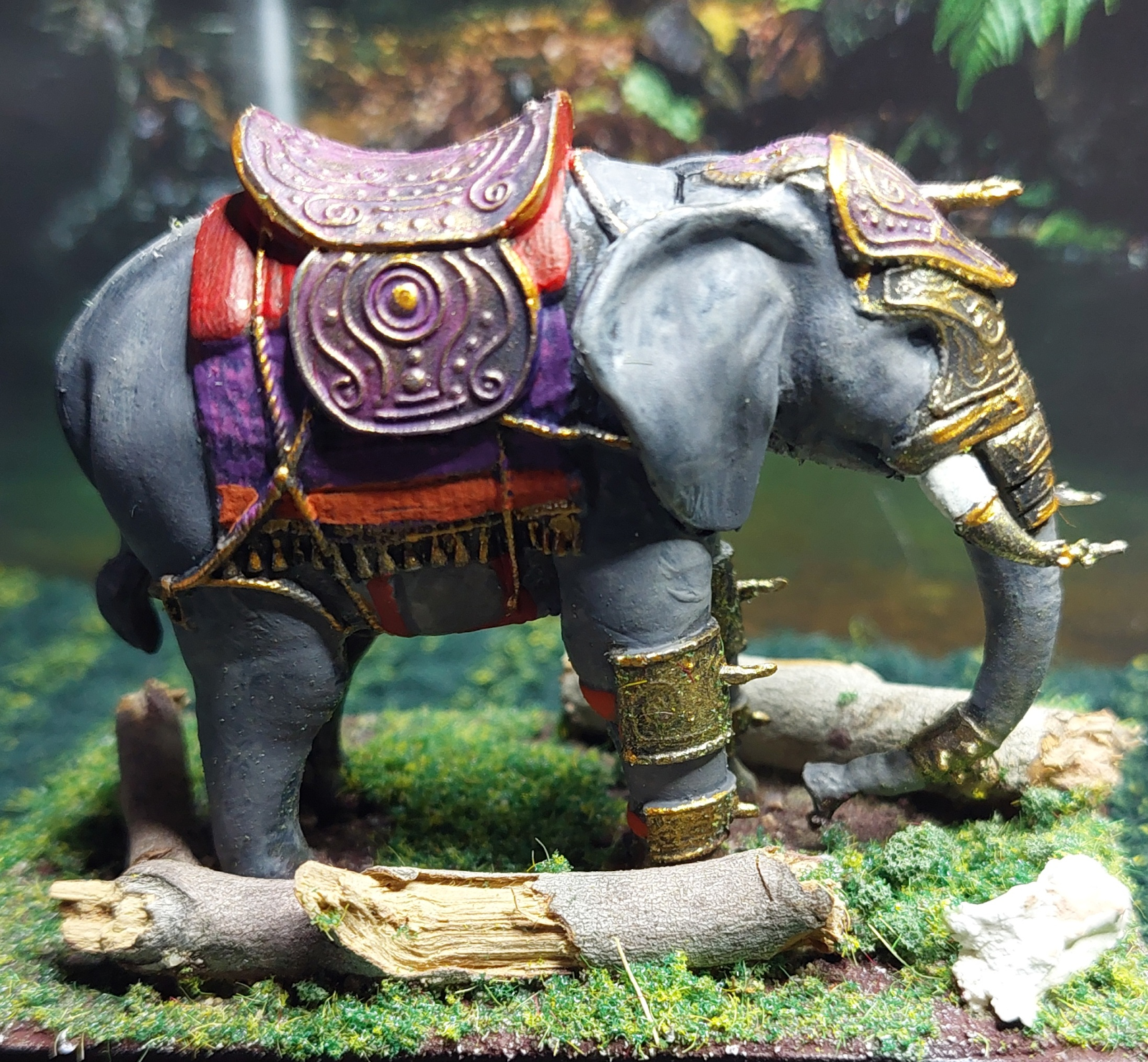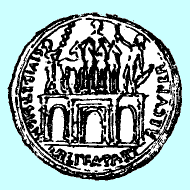One of the greatest concepts of Imperial China was that of the Civil Service Exam. Begun in a limited form in the Han Dynasty, it was formalized and improved by the Sui and fully implemented by the T'ang Dynasty. Originally intended to show the education level of the job candidate, the concept evolved into the current form where workers should be qualified to do the job.
The idea that a government employee should be qualified for the position that they held was in direct contrast to the traditional ideas of nepotism and favoritism where family and friends were given choice positions because of their "connections' rather than their ability to do the job. Simply put, Civil Service personnel have passed a test that shows they are qualified to complete the tasks of the government job they hold.
Wednesday, December 12, 2012
Tuesday, November 27, 2012
Barriers to Invading Ancient China
For thousands of years the culture of China has survived to form one of the most enduring civilizations in World History. One of the many reasons for this success has been the barriers to large invading armies that surround China. These can be divided into two groups, major natural barriers and manmade barriers.
Barriers are just that, difficult terrain for an enemy army to cross. Determined armies can succeed in crossing them but at such a cost in men and materials that can be deemed to high for all but the most determined foes.
Natural:
Seas- Japan, Yellow, East China South China
Mountains- Himalayas, Altan
Rivers- Huang, Yangtze
Jungles of Southeast Asia
Deserts- Gobi, Taklimakan
Manmade:
The Great Wall and the Grand Canal
Thursday, November 15, 2012
Major Dynasties of China
Shang
ca. 1650-1027 B.C.E.
First Dynasty, known for skilled work with bronze tools and art. Chinese writing created, ancestor worship becomes the
central religion.
Inventions: Silk refining
Zhou
1027-256 B.C.E.
Feudal system of government introduced; seen
as a golden age of peace by Confucius and later philosophers. Rulers
“Mandate of Heaven” first appears.
Inventions: Crossbow (450)
Warring States Period
481-221 B.C.E.
Huge armies controlled by
warlords divide China; as a counter, Confucius creates his philosophy of
respect/ancestor worship/kindness/obedience.
Inventions: Sun Tzu writes the Art of War, first military textbook
Qin (Ch’in)
221-207
B.C.E.
Pronounced
Chin, First Emperor, unites China, completes the
Great Wall, repression of knowledge/philosophy, creates imperial plan of rule; although
the shortest dynasty, so firm is Qin’s legacy of imperial control that China is forever named for
the 1st Emperor: Qin Shi Huang-di.
Great Wall, repression of knowledge/philosophy, creates imperial plan of rule; although
the shortest dynasty, so firm is Qin’s legacy of imperial control that China is forever named for
the 1st Emperor: Qin Shi Huang-di.
Inventions:
Wheelbarrow (220), Unifies the written language, measurements & money of
China
Han
207 B.C.–220 C.E.
Creates Civil Service, state
run factories control manufacture of luxury, commercial and
military goods.
Inventions: Horse Collar
(150 BC), Writing paper, blast furnace (100 AD),
cast-iron, cast-iron plow, fishing
reel (200)
Period of
Disunity
221-580
Jin Dynasty 265-316 fails to unify China
Inventions: Rudder (400),
matches (577)
Sui
580-618
Reunites northern and
southern China, digs the Great Canal between the Yangzi and Yellow
Rivers, repairs the Great Wall.
T’ang
618-906
Cultural renaissance,
improve civil service exams to reward merit, China again becomes a regional and world power,
Lao Zi creates Daoism, a religion of natural harmony.
Inventions: Gunpowder, Brandy (650), woodblock printing (760),
paper money (760)
Five Dynasties
907-960
Northern China ruled by
foreigners, Southern China divides into petty kingdoms, Liang, Tang, Jin,
Han & Zhou.
Song
960-1279
A reunited China
Inventions:
Bicycle chain (976), movable type (1041),
mechanical clock (1088), compass (1100), medical encyclopedia (1111), Windmill
mechanical clock (1088), compass (1100), medical encyclopedia (1111), Windmill
Yuan (Mongols)
1279-1368
Foreign dynasty of “Barbarian”
Mongols, Kublai Khan fails in two attempts to conquer Japan, Beijing becomes capital,
entire Silk Road is under Mongol (Pax Mongolica) control
increasing trade and allowing Europeans (Marco Polo) to visit China.
Inventions: Guns (1288)
Ming
1368-1644
Last Chinese dynasty,
Admiral Zheng He explores from China
Qing (Manchu)
1644-1912
Foreign dynasty from Manchuria , in constant fear of Chinese revolt, the Qing
cling to the past traditions, for the first time Chinese technology falls
drastically behind
Western/European, by the 1800’s European military might ellipses Chinese, twice conquering
Beijing and looting the Forbidden City, forcing the Qing to make massive
humiliating political/economic concessions to Western powers including the
Westernized Asian nation of Japan. The
last emperor is deposed in 1912.
Chinese
Republic
1912-1949
Never a true republic, China was largely controlled by
local warlords, communists, puppet governments and Japanese
troops.
People’s
Republic of China
1949-Present
After decades of conflicts
including civil strife, Japanese invasion, World War II, and open civil
war, the Chinese Communist Party takes total control of China
Wednesday, November 14, 2012
The Mandate of Heaven-the right to Rule the Middle Kingdom
The Mandate of Heaven is the divine (God ('s) given) right to rule the Middle Kingdom given to the Emperor, it is given based on four principles:
- The right to rule is granted by Heaven (realm of the Jade Emperor).
- There is only one Heaven therefore there can be only one ruler.
- The right to rule is based on the high virtue (Confucian principles of quality of his leadership) of the ruler.
- The right to rule can be passed down to family members of the dynasty but is not limited to one dynasty. (poor quality rulers/dynasties can lose the Mandate of Heaven and be replaced. The mere fact that a leader has been overthrown is itself proof that he has lost the Mandate of Heaven.)
Monday, November 12, 2012
Hannibal of Carthage
In 247 BCE, the year before the start of the 1st Punic War a son was born to Carthaginian general Hamilcar Barca, the proud father named his young boy...Hannibal. In the wake of Carthages' loss to Rome in the 1st Punic War, Hamilcar with his young son, set the groundwork preparing for the next war by establishing Carthaginian control over much of the rich province of Spain. At the age of twenty-six, Hannibal took control of the Carthagian forces in Spain and readied for war with Rome. In 219 BCE, he judged the time was ripe and lured the Romans into war by attacking and looting one of their client city states-Saguntum. The decisive conflict between Roma and Carthage for supremacy of the Mediterranean had begun-the 2nd Punic War.
From 218-209 BCE, Hannibal's brilliant tactics out maneuvered the Romans and brought the Republic nearly to its knees. His passage through the Alps and massive defeats of the famed Roman Legions at the battles of Trebia, Lake Trasimene and Cannae (where the Roman Army of over 85,000 was virtually annihilated) are still studied by historians and military experts today. Yet with all his victories the Romans continued to thwart Hannibal's goal of total victory. New armies were raised, improved tactics were installed (including the "Fabian Strategy" where attrition not pitched battles wore the forces of the enemy down), better generals were chosen, and the war was taken to the shores of Africa by the Romans.
In his last great battle, at Zama in 202 BCE, Hannibal was finally defeated by a Roman General, Publius Cornelius Scipio Africanus. Forced to abandon the Carthage he loved, Hannibal fled to the perceived safety of the Eastern Kingdoms, but the long arm of Rome followed him and circa 183 BCE, one of the greatest military leaders in history died by his own hands rather than be taken prisoner by his hated enemies the Romans. He had failed to save Carthage (which would be totally destroyed by Rome in 146 BCE), but through his greatness he earned immortality for himself and the memory of his once great nation.
From 218-209 BCE, Hannibal's brilliant tactics out maneuvered the Romans and brought the Republic nearly to its knees. His passage through the Alps and massive defeats of the famed Roman Legions at the battles of Trebia, Lake Trasimene and Cannae (where the Roman Army of over 85,000 was virtually annihilated) are still studied by historians and military experts today. Yet with all his victories the Romans continued to thwart Hannibal's goal of total victory. New armies were raised, improved tactics were installed (including the "Fabian Strategy" where attrition not pitched battles wore the forces of the enemy down), better generals were chosen, and the war was taken to the shores of Africa by the Romans.
In his last great battle, at Zama in 202 BCE, Hannibal was finally defeated by a Roman General, Publius Cornelius Scipio Africanus. Forced to abandon the Carthage he loved, Hannibal fled to the perceived safety of the Eastern Kingdoms, but the long arm of Rome followed him and circa 183 BCE, one of the greatest military leaders in history died by his own hands rather than be taken prisoner by his hated enemies the Romans. He had failed to save Carthage (which would be totally destroyed by Rome in 146 BCE), but through his greatness he earned immortality for himself and the memory of his once great nation.
As a North African general Hannibal used war-elephants in his army. One of his many feats was to not only cross the Alps into Italy with his army, but he was also able to bring some African war-elephants through the frozen passes. Unfortunately, most of the animals perished before any major battles with the Romans so their military contribution was nil.
This is a plastic model I painted in 2022.
The Cataphract-Heavy Armored Cavalry
The cataphract was the Ancient Worlds "tank." Heavily armored and armed, the cataphract was the ultimate shock force of well-formed and trained armies, as only these could afford large units of these tremendously expensive cavalrymen. They were used the greatest and most effectively in the armies of the Eastern Roman (Byzantine) Empire and Persian Empire in the centuries before the formation of the European knights. For centuries, cataphracts ruled the battlefields of the East while Western Europe was in the throes of the Dark Ages.
Greek Fire
The greatest secret weapon of Eastern Roman Empire was Greek Fire, a ship born terror weapon that ignited on contact and burned on water. Fired from a brass tube, the flaming liquid was as devastating to morale as it was to the wooden ships of the era. It is thought to have been invented by a Jewish Syrian Engineer named Callinicus (Kallinikos) in the mid 7th century. To keep it from enemy hands, the secret formula was known to a very small number of people (around three). This is also the reason the formula is unknown today for by the mid 13th century, some tragic event killed all those with the knowledge before it could be passed on.
Wednesday, November 7, 2012
Barbarians then Countries Now
For centuries the Roman Legions fought waves of "Barbarian" invaders from the East that attacked the Roman Empire looking for loot, as well as new lands to settle and claim for their own. In the end, the Western Roman Empire was completely overrun by the Barbarian tribes and the face of Europe was changed forever. While many of the barbarian tribes have faded from history their names have come down through time in the form of countries and territories whose modern names remind us of those who brought the Western Roman Empire to her knees. Here are a few of the most recognizable of theses once infamous (to the Romans) barbarian tribes:
Countries:
Anglo-Saxons-England
Belgae-Belgium
Bulgars-Bulgaria
Belgae-Belgium
Bulgars-Bulgaria
Franks-France
Germani-Germany
Helvetii- Confederation Helvetica (Switzerland)
Scots-Scotland
Helvetii- Confederation Helvetica (Switzerland)
Scots-Scotland
Ottoman Turks-Turkey
Territories:
Bavarii-Bavaria (Germany)
Bavarii-Bavaria (Germany)
Burgundians-Burgundy (France)
Lombards- Lombardy (Italy)
Lombards- Lombardy (Italy)
Jutes-Jutland (Denmark)
Saxons-Saxony (Germany)
And while not a country, one barbarian tribal name comes down to the present-day a a word synonymous with wanton destruction for the fun of the doing the destruction, the dreaded Vandals have become the term vandalism.
Thursday, October 18, 2012
The Arch of Victory
Since the age of Rome, great triumphal arches have been built to glorify the conquests of a great leader. One of the oldest known was the 29 BCE Arch of Augustus that once graced the road by the Temple of Vesta in Rome. The arch commemorated the victory of Augustus over Marcus Antonius at Actium. The arch no longer exists and only coins of the era give any idea as to its design.
Around 1806, Napoleon ordered the construction of the 19m tall by 23m wide, L'arc de Ttriomphe du Carousel.
The L'arc de Triomphe du Carousel was built to honor the great French victories of the previous year. It was modeled after the 23m tall by 25m wide, 203 C.E. victory arch of Roman Emperor Septimius Severus.
For his greatest arch, in 1806, Napoleon decided to create the gigantic-Arc de Triomphe, one of the largest arch's ever built (the 1982, triumph arch in Pyongyang is 10 m higher) to honor military victories. Based on the 1st century 15m tall Arch of Titus, the Arc is a massive 50m tall and 45m wide and took over 30 (although construction was halted for nine years due to regime changes) years to complete.
Wednesday, October 3, 2012
"Carthage Must Die"
For more than a century the two greatest powers of the Western Mediterranean Sea, Rome and Carthage competed for supremacy. Three brutal wars were fought between the two powers, the 1st Punic War (246-241 BCE), the 2nd Punic War (218-201 BCE) and the final, 3rd Punic War (149-146 BCE).
In the 1st Punic War (Punic came from Punicus, the Latin word for Phoenicians as the Carthaginians were called by the Romans.) was a victory for Rome who won her first overseas province, Sicily, the beginning of the Roman Empire. In the 2nd Punic War, Rome overcame several massive defeats at the hands of the Great Carthaginian General Hannibal and again defeated the Carthaginians.
During the uneasy peace after the 2nd Punic War many Romans felt the only lasting solution to the War many dangers of Carthage was the total destruction of the city. The great Roman senator, Cato the Elder, expressed this deep hatred through his famous comment "Carthago delenda est," ("Carthage must be Destroyed") that he added to the end of every speech he made in the Senate. The death of Carthage came in the 3rd Punic War, where 80% of her population died, the rest were sold into slavery, the city was burned to the ground, the soil plowed with salt and the land cursed (the Romans really hated Carthage). With her greatest rival destroyed, Rome was now the sole major power in the West and well on the road to becoming one of the greatest Empires in World History.
In the 1st Punic War (Punic came from Punicus, the Latin word for Phoenicians as the Carthaginians were called by the Romans.) was a victory for Rome who won her first overseas province, Sicily, the beginning of the Roman Empire. In the 2nd Punic War, Rome overcame several massive defeats at the hands of the Great Carthaginian General Hannibal and again defeated the Carthaginians.
During the uneasy peace after the 2nd Punic War many Romans felt the only lasting solution to the War many dangers of Carthage was the total destruction of the city. The great Roman senator, Cato the Elder, expressed this deep hatred through his famous comment "Carthago delenda est," ("Carthage must be Destroyed") that he added to the end of every speech he made in the Senate. The death of Carthage came in the 3rd Punic War, where 80% of her population died, the rest were sold into slavery, the city was burned to the ground, the soil plowed with salt and the land cursed (the Romans really hated Carthage). With her greatest rival destroyed, Rome was now the sole major power in the West and well on the road to becoming one of the greatest Empires in World History.
Friday, September 21, 2012
Renaissance Cannon - Death with a Bang
"Vive le Roi," (Long Live the King), cannon of the armies of the king of France. Note the fleur de lys design embossed on the barrels.
A deadly serpent ready to strike.
Ottoman splendor that brought death to the enemies of the Sultan.
Early bombards such as this spelled doom to the tall Medieval castles that had protected the nobles for centuries.
The development of artillery was a trial-and-error process. Some ideas such as this early breech loading design were centuries ahead of their time (in other words, a good idea that couldn't safely work with the metallurgy of the era)
But some improvements were very successful as this improved bombard clearly shows.
The last sight any enemy would want to see, the mouth of one of the improved artillery pieces right before it goes BOOM!
Friday, September 14, 2012
Thursday, September 13, 2012
Renaissance Armor-High Point of Personal Protection
From elite (and expensive) Imperial plate armour, ribbed for extra strength (don't worry about the open space between his legs-it and his bottom would have been covered by more flexible chain-mail armour),...
to common (cheap) leather and metal gorget (protected the throat and upper chest) ...
and simple brigantine (leather with metal studs), armor has protected warriors for thousands of years. Here we have samples of the best of the Renaissance armor maker's work. These are but a few of the hundreds of full and partial suits found at the Musee de l'Armee at Hotel des Invalides.
One size did not fit all, quality suits of plate were tailored for the individual user, one reason for their tremendous cost.
Suits of full plate were even made for wealthy young boys for training as well as protection should they accompany their fathers onto the battlefield.
And let's not forget our four-legged friends, armor for them could cover as little as their foreheads...
our encase both them and their riders in complete metal protection.
Those that could afford the best, purchased full plate for both man and beast (at a cost in modern dollars of over a quarter million).
But an new technology was to soon be so effective as to render the wearing of expensive plate armor useless-the flintlock musket. Easier to use than previous weapons and deadly up to seventy-five yards through even the best armor of the day.
Friday, August 31, 2012
Ancient Chinese Inventions-an Ancient Cultures Gifts to the World
Pasta-circa 2000 BCE
Crossbow- 5th Century BCE, Zhou Dynasty
Sun Tzu's The Art of War-circa 5th Century BCE, Warring States Period
Wheelbarrow-3rd Century BCE, Qin Dynasty
Horse Collar- 2nd Century BCE, Han Dynasty
Writing Paper- 1st Century CE, Han Dynasty
Blast Furnace- 1st Century CE, Han Dynasty
Cast Iron- 2nd Century CE, Han Dynasty
Seismograph- 2nd Century CE, Han Dynasty
Cast Iron Plow- 2nd Century CE, Han Dynasty
Fishing Reel- 2nd Century CE, Han Dynasty
Ships Rudder-3rd Century CE, Period of Disunity
Matches-6th Century CE, Period of Disunity
Porcelain- 6th Century CE, Sui Dynasty
Toilet Paper- 6th Century CE, Sui Dynasty
Gunpowder-7th Century CE, T'ang Dynasty
Fireworks-7th Century CE, T'ang Dynasty
Brandy-7th Century CE, T'ang Dynasty
Woodblock Printing- 8th Century CE, T'ang Dynasty
Paper Money-8th Century CE, T'ang Dynasty
Bicycle Chain-10th Century CE, Song Dynasty
Movable Type-11th Century CE, Song Dynasty
Mechanical Clock-11th Century CE, Song Dynasty
Compass-12th Century CE, Song Dynasty
Medical Encyclopedia-12th Century CE, Song Dynasty
Windmill-12th Century CE, Song Dynasty
Guns-13th Century CE, Yuan Dynasty
Monday, June 4, 2012
Cardinal Richelieu Master of 17th Century European Politics
Armand Jean du Plessis, Cardinal-Duc de Richelieu et de Fronsac (1584-1642), Chief Minister of France -1624-1642. An expert at Machiavellian Politics and intrigue... " I have made the King (Louis XIII) the most powerful monarch in Europe...while I am the most powerful man in France" Chooses Nationalism over religion during the Thirty Years War when he supported the Protestant factions over the Catholic Hapsburg Alliance. Thus were the major ideological wars of religion replaced by wars for the national interest. The Age of Enlightenment was at hand.
Louis XIII (1601-1643), King of France 1610-1643. A weak king under the constant influence of others, first his mother, Marie de Medici and later the powerful Cardinal- Richelieu.
Thursday, May 24, 2012
Hidden Gold, Lost Cities, Endless Quest-El Dorado.
For centuries the lure of vast treasures, lost civilizations and cities of gold hidden in the wilds of the New World have fevered the minds of explorers and adventurers, congealing in the magic term-El Dorado. El Dorado ("the gilded one"), untold riches hidden from the greedy clutches of the Europeans by Ancient civilizations long lost to the knowledge of the rest of the World. Thousands have searched and died in failed attempts to find El Dorado. One time it was the "Seven Cities of Gold" in the Southwest, others involved hidden Inca cities in Peru or the fabulous wealth of Queen Calafia and her female warrior empire. The Jungles of the Amazon basin (also thought to be the home the the ferocious female warriors) were a favorite destination for countless expeditions.

Yet, no matter how many searched or the lives lost, none have come back with the treasure of El Dorado. The lure remains, the search continues the explorer travels on and on until
"...as his strength "Over the Mountains
Failed him at length, Of the Moon,
He met a pilgrim shadow- Down the Valley of the Shadow,
"Shadow," said he, Ride, boldly ride,"
"Where can it be-- The shade replied--
This land of Eldorado?" "If you seek for Eldorado!"
From Eldorado by Edgar Allen Poe 1849
Yet, no matter how many searched or the lives lost, none have come back with the treasure of El Dorado. The lure remains, the search continues the explorer travels on and on until
"...as his strength "Over the Mountains
Failed him at length, Of the Moon,
He met a pilgrim shadow- Down the Valley of the Shadow,
"Shadow," said he, Ride, boldly ride,"
"Where can it be-- The shade replied--
This land of Eldorado?" "If you seek for Eldorado!"
From Eldorado by Edgar Allen Poe 1849
Thursday, May 17, 2012
The Conquistador's-Warriors for Glory, God and Gold
From the 15th to 17 centuries a class of warriors roamed the globe searching for glory, wealth, the wish to spread the Catholic faith and new worlds to conquer for the Empires of Spain and Portugal-the Conquistadors. These warriors for glory, God and gold, believed they were spreading civilization and the True Faith to the barbarian pagans they conquered.

Armed with the latest weapons and armor yet developed in Europe and battle tested in both the Old and New Worlds, the conquistadors were a potent force in the capture of new colonies and destruction of numerous native cultures.

Across three continents, the conquistadors helped to spread the Roman Catholic faith as their armies always contained missionaries as well as warriors. (Note the image of the Virgin and Child on the flag and the soldiers in prayer in the background.)

By the end of the 17th century the Spanish and Portuguese Empires were on every known inhabited continent. Most of the New World was in the control of these two imperial titans, as was the vast natural wealth of these land. Other European countries were quick to follow the example of the conquistadors, and soon most of the New World was claimed as colonies by the powers of the Old World. The wealth they took would flow for centuries into the coffers of the Europeans further enriching their nations and encouraging yet more colonial expansion.
Armed with the latest weapons and armor yet developed in Europe and battle tested in both the Old and New Worlds, the conquistadors were a potent force in the capture of new colonies and destruction of numerous native cultures.
Across three continents, the conquistadors helped to spread the Roman Catholic faith as their armies always contained missionaries as well as warriors. (Note the image of the Virgin and Child on the flag and the soldiers in prayer in the background.)
By the end of the 17th century the Spanish and Portuguese Empires were on every known inhabited continent. Most of the New World was in the control of these two imperial titans, as was the vast natural wealth of these land. Other European countries were quick to follow the example of the conquistadors, and soon most of the New World was claimed as colonies by the powers of the Old World. The wealth they took would flow for centuries into the coffers of the Europeans further enriching their nations and encouraging yet more colonial expansion.
Wednesday, May 16, 2012
Columns-Keys to Grand Government Buildings
The Greeks designed three classic forms of columns for their largest buildings. These were easily identified by the designs on their capitals (the top part upon which the weight of the roof rests). These were the Doric, Ionic and Corinthian styles.

Doric Column is the simplest design with little or no embellishment on the capital. The columns were also wider at the bottom and most often is without a elaborate base, resting directly on the support floor.

Ionic Columns have the distinct scroll design, or volute as the Greek would call it, at the capital.

The Corinthian Column is the most elaborate of the three. Classic Corinthian columns are slender, usually fluted (vertically grooved), decorated with a capital of leaves (most often the acanthus) and scrolls.
Doric Column is the simplest design with little or no embellishment on the capital. The columns were also wider at the bottom and most often is without a elaborate base, resting directly on the support floor.
Ionic Columns have the distinct scroll design, or volute as the Greek would call it, at the capital.

The Corinthian Column is the most elaborate of the three. Classic Corinthian columns are slender, usually fluted (vertically grooved), decorated with a capital of leaves (most often the acanthus) and scrolls.
Monday, May 14, 2012
The Privateer Popular till the 19th Century
Privateers were privately owned ships that were equipped and crewed at private expense but were given official government license to attack, raid and harass the enemies of said government in time of war. Privateers were de-facto legal pirates that were supposed to be treated a legitimate combatant if captured. 
Privateers achieved their authority through the "Letter of Marque." The letter of Marque was a government commission and permission to a private citizen to build their own warships. The use of these warships was to gain "prizes" (captured enemy ships and their cargo) that would be sold in friendly ports. The government received up to twenty-five percent of the profit gained by the privateer from these auctions. This greatly added to the number of ships available to wage war upon an enemy for virtually no cost to the government.

The most famous privateer was Sir Francis Drake, sailing the Golden Hind, he became the first Englishman to sail around the globe (1577-79). In his attacks upon Spanish shipping on that voyage he brought home a treasure reported to be worth more than the entire yearly expenditures of the English Government (the capture of the Nuestra Señora de la Concepción alone netted more than 15 million dollars in today's money in gold, silver and jewels). His backers earned a 4700% return on the money they invested in his ships and crew for this epic voyage. He so angered the Spanish through his successful raids that they offered a 20,000-ducat reward for his capture (over 7 million dollars). It was never collected.
Merchant ships were large, slow targets for the smaller, faster privateers who preferred to capture rather than destroy these valuable targets. The lure of easy pickings brought many a privateer to sea during major conflicts (more than 1200 Letters of Marque were issued by the Americans during the Revolution alone).

Privateers tried to avoid battle with warships as the latter were usually better armed and carried little cargo of value. But occasionally the warships caught up with the privateers as in this action between the American Chasseur vs HMS St. Lawrence in the War of 1812. The American won, an unusual occurrence for privateers.

Privateers came in all sizes, brigs and sloops were the most common, but they could be small as this Confederate privateer during the American Civil War demonstrates. The American Civil War was the last major action by privateers, the Industrial Revolution, improvements in Naval technology and communications reduced the need and increased the risk to the point that privateering was no longer profitable. Future wars would see more deadly ships and subsurface vessels whose goal would be to destroy, not capture enemy commerce. The age of legal piracy was over.
Privateers achieved their authority through the "Letter of Marque." The letter of Marque was a government commission and permission to a private citizen to build their own warships. The use of these warships was to gain "prizes" (captured enemy ships and their cargo) that would be sold in friendly ports. The government received up to twenty-five percent of the profit gained by the privateer from these auctions. This greatly added to the number of ships available to wage war upon an enemy for virtually no cost to the government.
The most famous privateer was Sir Francis Drake, sailing the Golden Hind, he became the first Englishman to sail around the globe (1577-79). In his attacks upon Spanish shipping on that voyage he brought home a treasure reported to be worth more than the entire yearly expenditures of the English Government (the capture of the Nuestra Señora de la Concepción alone netted more than 15 million dollars in today's money in gold, silver and jewels). His backers earned a 4700% return on the money they invested in his ships and crew for this epic voyage. He so angered the Spanish through his successful raids that they offered a 20,000-ducat reward for his capture (over 7 million dollars). It was never collected.
Merchant ships were large, slow targets for the smaller, faster privateers who preferred to capture rather than destroy these valuable targets. The lure of easy pickings brought many a privateer to sea during major conflicts (more than 1200 Letters of Marque were issued by the Americans during the Revolution alone).
Privateers tried to avoid battle with warships as the latter were usually better armed and carried little cargo of value. But occasionally the warships caught up with the privateers as in this action between the American Chasseur vs HMS St. Lawrence in the War of 1812. The American won, an unusual occurrence for privateers.
Privateers came in all sizes, brigs and sloops were the most common, but they could be small as this Confederate privateer during the American Civil War demonstrates. The American Civil War was the last major action by privateers, the Industrial Revolution, improvements in Naval technology and communications reduced the need and increased the risk to the point that privateering was no longer profitable. Future wars would see more deadly ships and subsurface vessels whose goal would be to destroy, not capture enemy commerce. The age of legal piracy was over.
Friday, May 11, 2012
The Aztec Warrior
From the common conscript soldier to the elite "knights" of the Jaguar and Eagle Warriors, the Aztec Army was a brave confident force that had only known victory for over a century of conflicts-until the arrival of the Spanish in 1519.

This Jaguar Warrior clearly illustrates the two pieces of equipment most commonly used by Aztec warriors, the small shield and the stone edged wooden Maquahuitl sword.

Commanders with standards from the Codex Mendoza. Note the elaborate costumes, use of feathers and the razor-sharp stone tipped tepoztopilli spears (usually five and a half feet long) of the officers.
 Ranks awarded for captured prisoners and imperial officers, Codex Mendoza.
Ranks awarded for captured prisoners and imperial officers, Codex Mendoza.
The capture of prisoners was one of the main goals of Central American Pre-Colombian wars. Those who were most successful quickly rose in rank and privileges within the army and society. Here in the codex are listed the stages of honors given to a warrior for the increasing numbers of prisoners captured. Note the sixth honor is entry into the elite Jaguar Warrior Class. The Lower eight figures are officers of the empire. The rank is delineated by the ever more elaborate feathers and costume design of the officers.

Warriors armed with the Maquahuitl (obsidian sword) and shield, note the eagle warrior in the lead, from the Florentine Codex.
Ranged weapons were varied and included:

The atlatl,a spear thrower that allowed longer range than a basic hand thrown spear.
The tlahuitolli, bow, ranged from light weight with short range weapons to some heavy weight that reportedly had a range of several hundred yards. All bows fired the mitl-stone tipped arrow.
The tematlatl was a sling made from maguey fiber. This was the ranged weapon most feared by the Spanish as it was often aimed at the unprotected face with deadly accuracy.
In addition to the maquahuitl and tepoztopilli, Aztec soldiers had access to a variety of additional wood and stone hand weapons.
The huitzauhqui was a club/mace sometimes with obsidian blades. These were about the size of a modern baseball bat but could be up to twice this size when yielded by a very strong warrior.
The tecpatl was a double-bladed dagger with a nine-inch length, excellent for close in fighting.
A weakness of all Aztec weapons was their stone and wood construction. The former dulled or chipped readily and the latter was no match against steel blades.
Protective gear/armor of the Aztecs was very minimal. It was designed to be light and give a limited protection against the stone tipped weapons of the Aztecs traditional Central American enemies. This equipment was basically made of two items the Chimalli and the Ichcahuipilli.
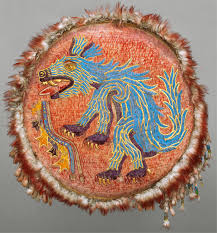
The Chimalli were small round shields made of wood or woven cane stalks often covered with cloth or feathers. They could be elaborately decorated for warriors of importance.
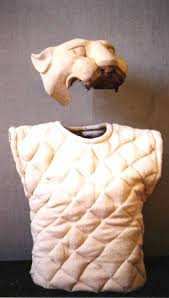
The Ichcahuipilli was a form of quilted cotton armor and inch or two thick. This padding was normally worn over the chest and back with the arms and legs unprotected. This gave such good protection against Indian stone tipped arrows that many Spanish soldiers would adopt this armor and continue to wear this style of protection when facing Indians well into the 18th century.
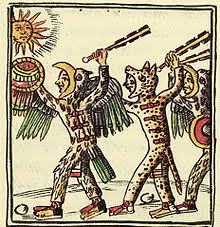 Eagle and Jaguar Warriors from the Codex Mendoza.
Eagle and Jaguar Warriors from the Codex Mendoza.
The tlahuiztli were the distinctive costume suits worn by the elite warrior classes. These usually covered the entire body including the head which often was covered in a form of helmet. These suits give a limited additional armor covering-especially if the costume included leather animal skins.
While adequate against their traditional enemies, the protective gear of the Aztec warriors was virtually useless against the steel weapons, iron tipped crossbow bolts, musket and cannon balls of the Spanish.
Aztec weapons could and did maim and kill their enemies who were similarly armed and protected. But in most conflicts capture of enemies was much preferred over killing them-dead men could not be sacrificed to the gods. So, it is not surprising that the majority of Aztec weapons could be readily used to stun an opponent to ease in his capture. This tactical choice and the limited strength of Aztec weapons and armor would prove a great hindrance to their army when they met the modern armed forces of the Spanish.
This Jaguar Warrior clearly illustrates the two pieces of equipment most commonly used by Aztec warriors, the small shield and the stone edged wooden Maquahuitl sword.
Commanders with standards from the Codex Mendoza. Note the elaborate costumes, use of feathers and the razor-sharp stone tipped tepoztopilli spears (usually five and a half feet long) of the officers.
The capture of prisoners was one of the main goals of Central American Pre-Colombian wars. Those who were most successful quickly rose in rank and privileges within the army and society. Here in the codex are listed the stages of honors given to a warrior for the increasing numbers of prisoners captured. Note the sixth honor is entry into the elite Jaguar Warrior Class. The Lower eight figures are officers of the empire. The rank is delineated by the ever more elaborate feathers and costume design of the officers.
Warriors armed with the Maquahuitl (obsidian sword) and shield, note the eagle warrior in the lead, from the Florentine Codex.
Ranged weapons were varied and included:
The atlatl,a spear thrower that allowed longer range than a basic hand thrown spear.
The tlahuitolli, bow, ranged from light weight with short range weapons to some heavy weight that reportedly had a range of several hundred yards. All bows fired the mitl-stone tipped arrow.
The tematlatl was a sling made from maguey fiber. This was the ranged weapon most feared by the Spanish as it was often aimed at the unprotected face with deadly accuracy.
In addition to the maquahuitl and tepoztopilli, Aztec soldiers had access to a variety of additional wood and stone hand weapons.
The huitzauhqui was a club/mace sometimes with obsidian blades. These were about the size of a modern baseball bat but could be up to twice this size when yielded by a very strong warrior.
The tecpatl was a double-bladed dagger with a nine-inch length, excellent for close in fighting.
A weakness of all Aztec weapons was their stone and wood construction. The former dulled or chipped readily and the latter was no match against steel blades.
Protective gear/armor of the Aztecs was very minimal. It was designed to be light and give a limited protection against the stone tipped weapons of the Aztecs traditional Central American enemies. This equipment was basically made of two items the Chimalli and the Ichcahuipilli.
The Chimalli were small round shields made of wood or woven cane stalks often covered with cloth or feathers. They could be elaborately decorated for warriors of importance.
The Ichcahuipilli was a form of quilted cotton armor and inch or two thick. This padding was normally worn over the chest and back with the arms and legs unprotected. This gave such good protection against Indian stone tipped arrows that many Spanish soldiers would adopt this armor and continue to wear this style of protection when facing Indians well into the 18th century.
The tlahuiztli were the distinctive costume suits worn by the elite warrior classes. These usually covered the entire body including the head which often was covered in a form of helmet. These suits give a limited additional armor covering-especially if the costume included leather animal skins.
While adequate against their traditional enemies, the protective gear of the Aztec warriors was virtually useless against the steel weapons, iron tipped crossbow bolts, musket and cannon balls of the Spanish.
Aztec weapons could and did maim and kill their enemies who were similarly armed and protected. But in most conflicts capture of enemies was much preferred over killing them-dead men could not be sacrificed to the gods. So, it is not surprising that the majority of Aztec weapons could be readily used to stun an opponent to ease in his capture. This tactical choice and the limited strength of Aztec weapons and armor would prove a great hindrance to their army when they met the modern armed forces of the Spanish.
